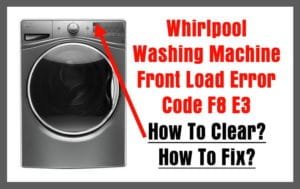
So, what’s up with this E3 error? In essence, it’s the machine’s way of signaling a problem with the drain motor. Picture your washing machine as a well-choreographed dance between water and mechanical parts. When something disrupts that flow, like a backup in the drainage system, the machine can’t do its job effectively. It’s like trying to dance with a shoe untied—bound to trip up eventually. Recognizing the signs early and knowing when to call in the experts can make all the difference.
Understanding the E3 Error Code
The E3 error code is essentially your washing machine saying, “I can’t drain!” This usually arises from a malfunction in the drainage system. Imagine trying to empty a bucket with a blocked spout—it would be a slow, messy process. That’s what your washing machine faces when it can’t drain properly due to this error. Typically, the E3 code indicates a failure in the drain pump or a blockage somewhere in the drain hoses.
There are a few possible causes for this error. It could be as simple as a kinked drain hose or as complex as a faulty drain motor that needs professional attention. Sometimes, small items of clothing can get lodged in the drain pump or hose, causing a blockage. It’s a common scenario, much like trying to sip through a straw that’s got something stuck in it. To get that refreshing drink of clean clothes, the blockage needs to be cleared.
Sometimes, though, it’s not just about blockages. The error could be pointing to something more serious, like an electrical issue within the motor itself. In this case, it’s a little like trying to listen to music with faulty headphones—something might be transmitting signals, but the system is unable to process them properly. If that’s what’s happening, it’s time for some expert advice to decide whether a repair or replacement is in order.
Signs It’s Time to Call a Technician
So, when do you actually pick up the phone and call a technician? To put it simply, if you’ve tried all the basic troubleshooting steps and the error code is persisting, it’s time to bring in some professional help. A little like getting a doctor’s opinion when a cough doesn’t go away, a technician can accurately diagnose and fix complex issues that you may not be equipped to handle.
If you’ve cleared out any visible obstructions and ensured the hoses aren’t kinked or blocked, yet your washing machine remains uncooperative, these could be signs of deeper mechanical issues. At this point, a technician can inspect and identify if the problem lies with the drain motor or any internal components. They have the tools and know-how to tackle the job safely and efficiently.
Another red flag is if you hear unusual sounds coming from your machine during the drain cycle. Grinding or clanking noises are often indicators that something beyond basic troubleshooting is needed. It might seem tempting to keep poking around in a DIY attempt, but this could lead to more harm than good. It’s crucial to know when you’re out of your depth to prevent costlier repairs down the line.
Preventative Measures and Final Thoughts
While calling a technician can solve immediate problems, preventing them in the first place is always ideal. Regular maintenance is key. Ensure that you’re not overloading your machine and that items like coins or small clothing don’t find their way into the drain system. Think of it as preventative health care for your appliance—routine check-ups and proper care can keep things running smoothly and avoid unexpected breakdowns.
Additionally, periodically cleaning the lint trap and checking the drain hoses helps ensure there are no clogs or buildup. It’s like clearing a pathway for the water to flow freely, maintaining optimal washing performance. Little steps like these go a long way in keeping that E3 error at bay and your laundry days hassle-free.
In conclusion, while dealing with an E3 error code can be a bit daunting, understanding what it means and knowing when to call for professional help can save you stress and money. With some basic home troubleshooting and the assistance of a qualified technician, you can ensure your Whirlpool washing machine continues to wash your clothes efficiently for years to come.